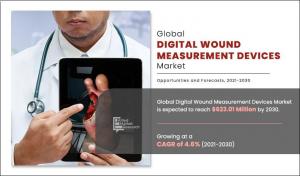Global Digital Wound Measurement Devices Market: Growth, Trends, and Outlook
What Are Digital Wound Measurement Devices?
Digital wound measurement devices leverage advanced imaging technologies—often paired with electronic medical record (EMR) integration—to accurately measure wound area, length, width, and depth in three dimensions. These devices produce visible, trackable records of wound changes over time, enabling:
Get a Sample Copy of this Report: https://www.alliedmarketresearch.com/request-sample/4578
Precise tracking of wound healing.
Improved documentation for healthcare providers.
Enhanced care coordination across clinical teams.
3D-enabled solutions are particularly valued for their ability to translate line tracings into actual wound area calculations and document progress over multiple visits.
Key Drivers of Market Growth
Several trends are driving demand for digital wound measurement solutions:
Aging Global Population: Increasing numbers of elderly individuals, who are at higher risk for chronic wounds (such as pressure ulcers and diabetic foot ulcers), create sustained demand.
Rising Chronic Disease Burden: Higher prevalence of diabetes, obesity, and other chronic conditions, partly due to lifestyle changes, leads to more complex wound management needs.
Demand for Healthcare Cost Containment: Providers and payers are focusing on technology to improve wound care efficiency and reduce hospital stays and readmissions.
Benefits of Digital Solutions: Enhanced accuracy, remote monitoring capabilities, and seamless integration with EMR systems.
Awareness and Accessibility: Growing awareness of wound care technologies, especially in emerging markets.
Market limitations include device constraints—such as inability to assess features like moistness or exudation—and the need for greater adaptability in complex wound scenarios.
COVID-19 Impact Analysis
The COVID-19 pandemic temporarily slowed market growth in 2020 due to:
Delayed elective surgeries and routine wound care.
Hospital closures or reclassifying wound clinics as nonessential.
Significant reductions in wound center visits (up to 40% decrease between 2019 and 2020).
However, adoption of telehealth accelerated in developed economies, paving the way for renewed growth in digital wound monitoring technologies as healthcare systems recovered from lockdowns.
Market Segmentation
By Product:
Non-Contact Wound Measuring Devices: Dominated the global market in 2020. These devices are prized for providing detailed wound images while avoiding patient discomfort and reducing infection risks.
Contact Wound Measuring Devices: Used in some applications but less preferred due to heightened risk of cross-contamination.
By Wound Type:
Chronic Wounds: The largest market share, driven by the increasing prevalence of pressure ulcers, diabetic foot ulcers, venous leg ulcers, and arterial ulcers.
Acute Wounds: Includes surgical wounds, burns, and trauma, with steady but slower market growth.
By End User:
Hospitals: Remain the top user segment due to high admission rates for acute and chronic wound treatment and greater adoption of advanced wound management technologies.
Community Centers: Also contribute to market growth, especially as outpatient, home-based, and telemedicine wound care expands.
Regional Insights
North America & Europe: Lead the market, driven by high healthcare spending, advanced infrastructure, and early adoption of digital health solutions.
Asia-Pacific: Expected to see the fastest growth rate, attributed to rising awareness, health infrastructure improvements, more advanced medical facilities, a growing target population, and increased demand in emerging economies.
LAMEA: Also experiencing increased adoption due to development initiatives in healthcare sectors.
Key Market Players
Notable companies driving innovation and market presence include:
Arnaz Medical Limited
BioVisual Technologies LLC
eKare Inc.
Kent Imaging Inc.
Net Health (Tissue Analytics, Inc.)
Perceptive Solutions, Inc.
Smith & Nephew Plc.
WoundMatrix, Inc.
WoundRight Technologies, LLC
WoundVision, LLC
These companies are focusing on product innovation, remote monitoring technologies, and seamless data integration with healthcare IT systems.
Outlook and Opportunities
The future of the digital wound measurement devices market looks promising, with substantial growth anticipated as healthcare systems worldwide:
Embrace digitalization for improved wound documentation and remote patient management.
Address unmet wound care needs in emerging markets.
Invest in non-contact, multi-parameter assessment tools for comprehensive wound management.
Enquire Before Buying: https://www.alliedmarketresearch.com/purchase-enquiry/4578
David Correa
Allied Market Research
+1 800-792-5285
email us here
Visit us on social media:
LinkedIn
Facebook
YouTube
X
Legal Disclaimer:
EIN Presswire provides this news content "as is" without warranty of any kind. We do not accept any responsibility or liability for the accuracy, content, images, videos, licenses, completeness, legality, or reliability of the information contained in this article. If you have any complaints or copyright issues related to this article, kindly contact the author above.
Redefining Recovery: Daniel Regan’s Healing Us Model Emerges as a Gold Standard for Community Transformation
EL ANTILLANO BAR ACERCA EL ESPÍRITU DE PUERTO RICO A MADRID
Golden State Gears Up for a Rum Renaissance: San Francisco Rum Festival & Congress Returns for its 10th Anniversary
Więcej ważnych informacji
 Jedynka Newserii
Jedynka Newserii

 Jedynka Newserii
Jedynka Newserii

Handel

Mercosur to tylko wierzchołek góry lodowej. UE ma ponad 40 umów handlowych, które mogą destabilizować rynek rolny
Umowa handlowa między UE a krajami Mercosur może znacząco zaburzyć konkurencję na rynku rolnym i osłabić pozycję unijnych, w tym polskich, producentów – ostrzegają rolnicy i producenci żywności. Umowie sprzeciwia się część krajów unijnych, które domagają się klauzuli ochronnych oraz limitów importowych. – Problemem jest jednak nie tylko ta konkretna umowa. Chodzi o cały system wolnego handlu, który się kumuluje z dziesiątek innych porozumień – podkreśla Andrzej Gantner, wiceprezes Polskiej Federacji Producentów Żywności.
Firma
Dzięki zdalnej weryfikacji tożsamości z wykorzystaniem AI firmy zminimalizowały liczbę oszustw. Rozwiązania wykorzystuje głównie sektor finansowy

Z najnowszych danych Eurostatu wynika, że w 2024 roku 5,9 proc. polskich firm korzystało z rozwiązań z zakresu sztucznej inteligencji. W 2023 roku był to odsetek na poziomie 3,67 proc. Wciąż jednak jest to wynik poniżej średniej unijnej, która wyniosła 13,48 proc. Jednym z obszarów, który cieszy się coraz większym zainteresowaniem wśród przedsiębiorców, jest weryfikacja tożsamości przez AI, zwłaszcza w takich branżach jak bankowość, ubezpieczenia czy turystyka. Jej zastosowanie ma na celu głównie przeciwdziałać oszustwom i spełniać wymogi regulacyjne.
Prawo
Daniel Obajtek: Własne wydobycie i operacyjne magazyny to filary bezpieczeństwa. Zgoda na magazyny gazu poza krajem to rezygnacja z suwerenności energetycznej

Były prezes Orlenu ostrzega przed zmianami w ustawie o zapasach ropy naftowej, produktów naftowych i gazu ziemnego. Jego zdaniem przygotowana przez rząd nowelizacja tzw. ustawy magazynowej i ujednolicanie unijnej polityki energetycznej to zagrożenie dla bezpieczeństwa energetycznego Polski. W jego opinii tylko silna spółka narodowa, własne wydobycie, krajowe magazyny i zbilansowany miks energetyczny zapewnią Polsce bezpieczeństwo i konkurencyjność.
Partner serwisu
Szkolenia

Akademia Newserii
Akademia Newserii to projekt, w ramach którego najlepsi polscy dziennikarze biznesowi, giełdowi oraz lifestylowi, a także szkoleniowcy z wieloletnim doświadczeniem dzielą się swoją wiedzą nt. pracy z mediami.





![Nestlé w Polsce podsumowuje wpływ na krajową gospodarkę. Firma wygenerowała 0,6 proc. polskiego PKB [DEPESZA]](https://www.newseria.pl/files/1097841585/fabryka-nesquik_1,w_85,r_png,_small.png)



.gif)

 |
| |
| |
|